Keri Wyatt Kent's Blog, page 6
December 2, 2021
How can you reduce holiday stress?

It is sunny and 54 degrees here in Chicago today, which is lovely. Except that it really doesn’t feel like December, and it’s making me deny reality: Christmas is a little over three weeks away, and I am way behind on getting gifts, decorating, and even on wrapping my brain around what I need to get done.
How are you doing with your Christmas prep? Are you feeling some stress about the holidays? If so, here’s a quick reminder: three things you can do to reduce holiday stress.
Choose your yes and no thoughtfully. We’re conditioned to say “yes” because we think it’s nicer or more generous or maybe more “Christian.” But here’s the thing: every yes is a no. When you say yes to doing one thing, you’ve automatically said no to any number of other things. So yes is not “nicer” or “better”–it’s simply a choice to say no to other things. Be honest with yourself about your capabilities and say yes to the things that bring you joy. Let other things go. Take your time, slow down before you say yes. By saying no to things that are non-essential, you’re free to say yes to what matters.Consider giving “experiences” rather than gifts. My kids have told me that they’d rather have me fund an experience than buy them more stuff. Who else might agree with that idea? Do any of us really need another sweater or Christmas candle? One of our gifts to our daughter and son-in-law was taking them to a professional football game. We made memories and had a great time.Take time for self-care. The first step to that? Slow down. The holiday season can be stressful. What are you doing to take care of yourself? Are you getting adequate rest? Can I suggest: taking just a few minutes a day to focus on things that really matter? And a great tool for that: my free ebook, The Gift of Christmas Present. Below you’ll find an excerpt to give you a taste of what’s in this little book.
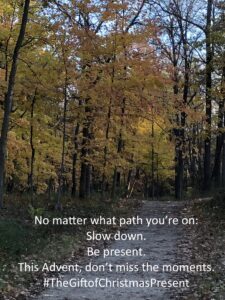
You can download a free ebook version in the box to the right on this page. Here’s a bit of the introduction:
Why does Christmas become a competition? What is it that we are trying to “win”? What is it that we are really seeking? Maybe: significance.
Which is not a bad thing to want. You were created for significance—in fact, you’re deeply loved and you already have significance. How much time do you spend seeking what you already have? You already have it—even if you don’t feel or recognize it yet. You don’t need to seek significance in things that cannot actually give it: accomplishments, busyness, stuff.
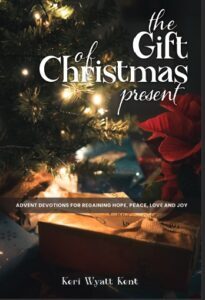 Our desire for significance might be fueling our crazy plans for cookies, decorating, gifts, parties. We want that cozy holiday feeling, we want to know that we created that wonderful moment, that amazing memory, that magical Christmas morning–and we make ourselves and everyone around us crazy trying to achieve it. But, instead of cozy, we feel pressure. Instead of joy, we feel stress.
Our desire for significance might be fueling our crazy plans for cookies, decorating, gifts, parties. We want that cozy holiday feeling, we want to know that we created that wonderful moment, that amazing memory, that magical Christmas morning–and we make ourselves and everyone around us crazy trying to achieve it. But, instead of cozy, we feel pressure. Instead of joy, we feel stress.
A lot of this is about our need to be okay, or even, amazing. The truth is, we want to win. We want to win Christmas. After last year, when many of us had to forgo gathering, there’s a pressure to make this year better than ever.
How can we regain our sanity? Well, I can’t promise you complete calm during the holiday season, but I do want to give you a gift: the gift of Christmas present. It’s actually a gift I want to guide you toward giving to yourself.
This devotional can help you to pause, for just five minutes a day, to slow down, to dial in to what you most want: a meaningful Christmas season. And that five minutes can help recalibrate and reconnect you to the four themes of Advent: hope, peace, love, and joy. It will give you some quiet thoughts to hang on to during your day, to help you to slow down and be fully present.
November 29, 2021
It’s not too late to make this Advent meaningful

Thank you!
I really appreciate how many of you have downloaded your free copy of the new ebook devotional, The Gift of Christmas Present. And still more of you have ordered the paperback version so you can journal right on the pages, or give one away as a gift!
This is Cyber Monday, but it is also the first week of Advent. And we hold these kind of things in tension, don’t we? A desire for meaningful holidays in one hand, our to-do list in the other.

Since you’re going shopping online today anyway, why not get yourself a little something that recognizes that struggle and helps you to meet it head on? It’s not too late to grab your copy of The Gift of Christmas Present, and make the next four weeks just a little more meaningful. Your free version is just two clicks away. In just a few minutes a day, you’ll read, reflect, journal and pray—helping you to slow down and simply be present during this hectic time of year.
If you’re like me and prefer a paperback version with room for journaling, you can order it here. While you’re waiting, download the free ebook version here (or in the box to the right) so you can jump in and start reading right away.
Again, thank you to all who’ve already downloaded, ordered a paperback, or both!
P.S. If you’ve started reading the book, I’d love to have you visit the amazon page and post a one-sentence review. Even if you downloaded the free version you can still review it on amazon. Thanks!
November 23, 2021
The Gift of Christmas Present devotional now in paperback!

Happy Thanksgiving! Although it’s our second holiday season in a pandemic, things have shifted. Perhaps this year, we will gather with friends and family. We can’t rely on past holidays to inform this season, except to say that it will probably be a little busier than last year.
What will you encounter over the next month? Some difficult conversations? Your normal hurry and hectic amped up like a toddler on too many sugar cookies? If we’ve learned anything in the past year or two, it’s to hold plans loosely–because things can change. But we summon the courage to change the things we can. And one thing we can change: our selves. So my question for you: what’s your self care plan for the next month and a half?

What habits or practices do you intend to engage in to keep your mind, spirit, and body well-tended, healthy, strong?
These things don’t just happen–they require intention and action. I’m just wondering if you need some help with that?
It might be that you’re already weary. And we’re just getting started on what is often the busiest and most emotionally fraught season of the year. What will you do to pause, to rest and refuel your soul this season?

I hope you’ll stop by this space and visit–the conversation here will be encouraging and simple. We’ll talk about soul care, about being kind to yourself, about faith. About some practices that may be helpful.
I also hope you’ll accept the free gift I’ve created for you: The Gift of Christmas Present, a free ebook that will guide you toward Hope, Peace, Love and Joy in the next four weeks. Advent begins this Sunday–so you’ll want to get it before then. Details about how to grab it are in the box to your right. Or just click here to download.
If you are not an ebook person (especially for devotions and journaling), I’ve got some big news: I’ve created a paperback version of The Gift of Christmas Present, with beautiful journaling pages added, which launches today. It’s a four-week daily devotional for just $7.99. You might want to give it as an early gift to yourself or a friend.
A soul care habit for the holidays? Maybe reading this devotional with a friend. Or stopping by here to discuss it, since it will be part of the conversation. Or taking time for yourself, just a few minutes of soul-healing solitude each morning to connect with God.
Spend five minutes a day in this book, and feel yourself begin to breathe. Each day’s entry includes a short Scripture, an encouraging reflection, a thought-provoking journaling question, and a simple prayer.
More than any time of year, the holidays are a time when focusing on the moment feels impossible. But what if you could take just a few minutes a day to slow down, breathe, and just be present? What if, instead of worrying about the future, or regretting the past, you could just receive the gift of Christmas present?
To get your copy (and one for a friend!) of the paperback version today, click here.
November 9, 2021
Rediscover the gift of Christmas present–with a free book!

This year, we’re feeling all the feelings about the holidays, and then some. More than ever, we want meaningful connection with people, around our table, if possible. We want to remember the real reason for the season but also go a little wild with celebrating just because we can.
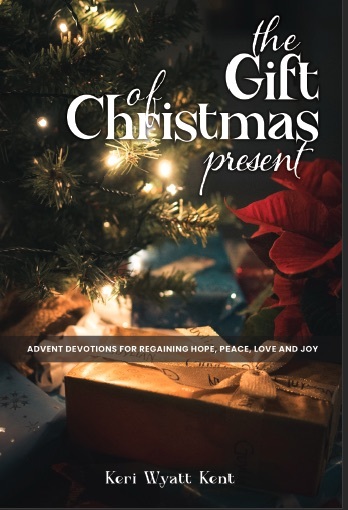 As the holidays approach, wouldn’t it be great if you could have a daily reminder to live in the moment each day? What if you had some gentle coaching on how to let go of past regrets and future worries, and just live in Christmas present?
As the holidays approach, wouldn’t it be great if you could have a daily reminder to live in the moment each day? What if you had some gentle coaching on how to let go of past regrets and future worries, and just live in Christmas present?
I want to give you that gift. For free! I’ve created a brand-new e-book, The Gift of Christmas Present: Advent Devotions for Regaining Hope, Peace, Love and Joy. In about five minutes a day, you can read Scripture, reflect, journal and pray your way through the four weeks leading up to Christmas.
Advent begins the Sunday after Thanksgiving. Grab early access to the free download before it is available to the public by requesting it via the subscription box to the right of this post. It’s my gift to my email friends. If you’re already a subscriber, please leave a comment below and I’ll email you the link to the free download.
Here’s a sneak peak of the first few paragraphs of this free resource, my gift to you:
There is a deep longing in our hearts, which the season of Advent intensifies. The longing is for presence, for meaning, for connection. With God, with others, with our own inner self.
The words of the prophet Isaiah resonate: the people walking in darkness have seen a great light. We are hoping to God it’s true, that the darkness is giving way, that the light of hope really is on the horizon.
If you are reading this, you are a survivor. You’ve survived a pandemic, not to mention chaos, vitriol and other traumas. In this post-traumatic state, restoration comes from acknowledging the struggles and stresses, then leaning into the source of healing: the Christmas child.
I can’t wait for you to enjoy this devotional. You’ll want to download it right away so you’ll be ready to start reading with us on November 28, the first Sunday of Advent. We’ll be talking about what we’re reading here on the blog, and on Instagram.
The greatest gift you can give yourself (and the people around you) is to be fully present in each moment. The Gift of Christmas Present will help you do that.
P.S. I’d love it if you tell a few friends about this book, and introduce them to me and my writing, so they can get their own copy. Send them a link or share my social media posts, if you’d be so kind! Thanks.
November 1, 2021
Is self-publishing right for you?


http://keriwyattkent.com/wp-content/u...
You’ve written a book (or are thinking about it). How do you get your words out into the world? Do you have a guide for the adventure of publishing?
I’m going to be teaching on this topic at the West Coast Christian Writers conference (which you can attend in person or virtually, learn more here) in February 2022. I’ve published dozens of books, but traditionally and via self-publishing.
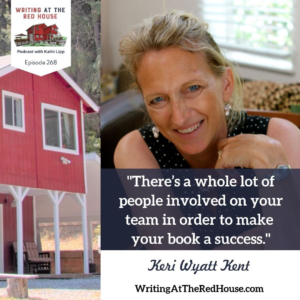 Want some self-publishing tips right away? Click over to listen to the Writing at the Red House podcast, where I have the privilege of being a guest today. Host Kathi Lipp and I are talking about all sorts of publishing adventures, including self-publishing.
Want some self-publishing tips right away? Click over to listen to the Writing at the Red House podcast, where I have the privilege of being a guest today. Host Kathi Lipp and I are talking about all sorts of publishing adventures, including self-publishing.
In the podcast, I mention a forthcoming ebook. If you’d like to get access to this resource for FREE, please leave a comment below, and I’ll be sure to send it to you as soon as it’s available.
October 4, 2021
Ready to welcome? Three easy ways to practice hospitality

Fall stirs in me a longing to gather people around my table, to practice hospitality. After months and months of social distancing and not gathering, I’m thrilled to be able to welcome friends to my home.
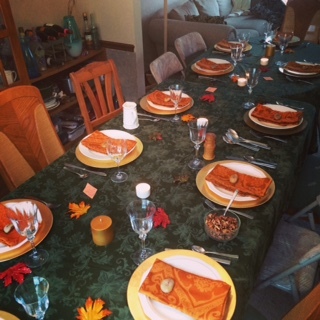
Feeling that same longing? Or feeling intimidated by the idea? Here are three easy ways to practice hospitality without getting stressed out.
See hospitality as a spiritual practice. Our culture misunderstands hospitality, confusing it with entertaining. The “hospitality industry” is even a thing—which of course is about profit, not expression of faith. But hospitality is a practice, not necessarily a gift. (Which means that anyone can do it.)I’ve been told numerous times I have a spiritual gift of hospitality. But when I read the Bible, I don’t see hospitality listed among the spiritual gifts. Hospitality is a spiritual practice, and it’s something that Jesus invites us to do, but it’s not a gift. The lists of gifts in the Bible are not necessarily exhaustive, but still—since the Bible talks a lot about hospitality, you think it would have made at least one of the top-ten lists. Nope.
I love the word “practice” because it precludes perfectionism. You’re not performing, just practicing, and mistakes and imperfections are expected. Spiritual practices are not ways to earn God’s favor. Nor are practices ideas that we simply think about or philosophical positions we affirm. Rather, practices are actions we literally do with our bodies that form us spiritually. Practices are not the same as gifts, although our gifts may shape the practices we are drawn to, and help us to grow. Practices draw us into God Space, invite us into intimacy.

With almost any spiritual practice, it’s easy to run ahead of God, focused on self-improvement that we think may earn favor. We tell God our plans, then ask for blessing. What would happen if instead, we begin with stillness, with paying attention to our deepest longings and knowing. And then tell God about that desire, and ask God to direct and lead us into action? Prayer is conversation, which means we listen, not just talk. Be an intentional listener.
Keep it simple (but have a plan). I know, there is some work involved with welcoming others to your home: everything from cleaning the bathrooms to setting the table to decluttering and oh, yes, cooking. Make lists, do as much as you can ahead, and keep as much as you can as simple as you can. This time of year, everyone loves soup, chili or stew—all easy to make ahead.When I have friends over, I make pie. Because I like making (and eating) pie. If you don’t enjoy baking, buy something delicious at the bakery and let it go.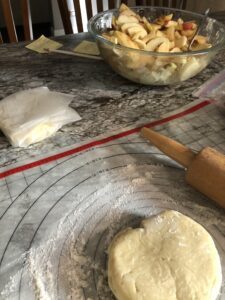

You do need a plan, only to free you to focus on what matters. Ask yourself how you can create a welcoming space without making it about you. Focus on loving, not on impressing. Hospitality is about love. In the bible, the invitation to extend hospitality is mentioned in the context of loving others. Some of us may be more comfortable with it than others, but we’re all asked to practice it.
Hospitality can be an expression of worship, because worship is more about serving than singing. The apostle Paul instructed believers, “Be devoted to one another in love. Honor one another above yourselves. Never be lacking in zeal, but keep your spiritual fervor, serving the Lord. Be joyful in hope, patient in affliction, faithful in prayer. Share with the Lord’s people who are in need. Practice hospitality” (Rom. 12:10–13).
Offering hospitality shows love to people. It is closely linked to both worship and generosity. We share our bread with those in need of food, or of fellowship, not to earn God’s favor but so that we might be transformed. Remember, the purpose of spiritual practices are not to get good at the practice. Practices shape us into people who are more like Jesus, and are more deeply connected to Jesus.
Hospitality is not about entertaining or perfectionism. It’s about love, letting the love God’s lavished on you spill over onto others.
Whether or not we’re gifted at love, Jesus asks us to love. And to welcome others. When we do so, we experience his love coming back to us in a fresh and transformative way.
Want to learn more about hospitality and other spiritual practices? Some of the content for this post was adapted from my book GodSpace: Embracing the Inconvenient Adventure of Intimacy with God, which has a whole chapter on hospitality and also guides you through six other spiritual practices. Get your copy here. Read other popular posts on hospitality here and here.
September 29, 2021
The curious connection between activity and creativity

I often get questions from readers about writing. How do you build a writing life? I think it begins with two things:
Schedule time to write. Do it as a daily practice.Schedule time to move. Do it as a daily practice.The common myth is that creativity and “schedule” are incompatible. But most writers will tell you that structure is what makes things happen.

Too often, would-be writers wait until they feel “inspired” to write, which means they don’t write. Or, they “take a break” from writing by scrolling social media, texting other writers, or buying books online and calling it research. (I know because I do these things.) These diversions are fine, but they don’t really provide the mental and physical break we need to actually boost our creativity. I’m a writer and a runner, and I don’t think I could be one without the other. These two disciplines complement, balance and fuel one other.
Writing engages our brain (and often our soul) in deep ways. It requires thoughtful reflection, and the discipline of showing up. The first step to becoming a writer is to write. Get your butt in the chair, show up at the page, set a goal for writing a set number of words per day.

Runners, similarly, begin by showing up: lacing up the shoes and putting one foot in front of the other. Running (or walking, or any other physical activity) is a discipline—but also a gift to yourself and your physical and emotional well being. It may seem purely physical, but pushing through mentally and emotionally is part of the game. As one of my favorite running memes says, “Running is 99 percent mental and the other half is physical.”
My running strengthens my body and mind. I think more clearly when I’ve taken some time to move. I’m less anxious, calmer, clearer. Although exercise isn’t rest, it tamps down my anxiety, lets my mind take a break. I’m a better writer when I run. Writing requires me to be in my head, and physically still. Running requires me to be in my body, and physically moving.
There’s a curious connection between activity and creativity. I learn about each by engaging in the other. You become a writer by writing, but also by taking time to do something other than write.

So perhaps the path to greater creativity begins with movement—physical activity. One begins by simply beginning—whether walking, jogging, running, or some combination thereof. Improvement comes from making a commitment to slowly building a running practice. Writing is the same. Make a commitment to slowly build a practice of writing. Strength builds slowly, but when it does, you sort of look at yourself in amazement.
Activity alone will not make you into a writer, of course. That physical activity must be one part of the writing life. But the other part, of course, is making time to actually write.
Running (or other activity) provides a framework for my days that enhances my writing. When I start my day with a run, or a walk, there’s a feeling of accomplishment. To run six miles before most people even get out of bed—that fires me up. And that accomplishment motivates me to do more—to not just run, but to write 1000 words, to tackle an editing project, to just get a rough draft on paper.
What do you think? How does activity impact your creativity?
September 27, 2021
Should you self-publish? Some writing advice…

Should you self-publish? I’ve been writing and publishing books for about two decades. Here’s some advice on publishing options.
I was on a trail ride with a group of friends the other day. As our horses walked along the edge of a field, one friend was curious about my work, since she mostly knows me as a rider, not a writer.
I help people turn their ideas into books, then guide them through the process of either self-publishing, or approaching an agent who might help them get the attention of a traditional publisher.
My friend told me about an acquaintance who had written a cookbook, and was rejected by traditional publishers because she didn’t have enough of a platform (i.e., followers on social media, podcast listeners or blog readers, radio or TV exposure, etc.).
Platform is essential for getting a book contract. Publishers want to know that you will bring them not just a great idea and stellar writing, they want you to “show them the readers.” They expect you to have a following, a tribe who will buy (and recommend) your book, and expect you to do most of the connecting with that tribe. (Michael Hyatt’s book Platform is an excellent primer on the topic.)
Most cookbooks, for example, are written by either celebrities, cooking show hosts, or by people who have a great food blog with a ton of followers (one of my favorites is Deb Perelman’s smittenkitchen.com). They build that audience by writing consistently great content (often accompanied by great photos).
My riding buddy said her aspiring cookbook author friend looked into “buying followers” which I guess is a thing. But, she continued, they turned out to be “Russian bots.” I’m not quite sure what that meant. But long story short, buying followers is not a good strategy as you pursue publication. Trying to fool a publisher into giving you a contract? Also NOT recommended.
Say you somehow convince a publisher you have 10,000 “followers.” For the sake of argument, let’s say they agree to publish your book (I’m NOT saying a publisher would be so easily hoodwinked.) Because your followers are not actual readers, your book does not sell well at all. You’ve destroyed the relationship with that publisher. You haven’t achieved the goal you thought traditional publishing would help you reach—widespread distribution. You’ve wasted money and time, and the only thing you have to show for it is a sullied reputation.
Whether you self-publish or seek out a traditional publisher, you want actual readers to read your book. So no matter what path you take to publication, you need to find a way to connect with readers. If you dream of publishing a book, the best place to begin is to understand your options.
Want to learn more about publishing?
Self-publishing can be daunting—and it does require an investment. Seeking a traditional publisher can also be a time-consuming and challenging endeavor. I’m excited to let you know that I’m going to be teaching on publishing options, and self-publishing, at the West Coast Christian Writers conference in San Francisco, California in February.
Of course I’d love to have you join us at the conference, either in person and online. Starting today, we’ll be writing about writing on this blog every Monday.
Today, I want to share some basics on publishing options (a sneak peek at my conference content). Which is right path to publication for you? That depends on how much time, money and energy you have to invest.
Traditional publishing (aka Royalty publishing)
It’s not easy to land a book deal, but royalty publishers pay you for the right to publish your book (and of course they get a big share of the profits if the book sells.)

Photo by Vlada Karpovich from Pexels
In order to approach a publisher, you will need a literary agent. Finding one to represent you means sending lots of queries, and writing a strong, well-developed book proposal (we’ll talk about what that includes in upcoming posts). You’ll send this proposal to agents in hopes of convincing them to represent you.If an agent agrees to represent you, they will query publishers, sending your proposal and negotiating on your behalf. (Agents only get paid if you get a contract.)If the publisher “buys” your book, they’ll offer you an advance (sometimes) and a small cut of the book sales proceeds—also known as royalties. This is spelled out in a contract, which obligates you to write the book by a certain deadline (and return the advance if you don’t). Your agent takes 15 percent or so, and is well worth that.The publisher provides editing and covers the costs of production (including the cover design, typesetting, binding, printing), and distribution (getting it into bookstores and online sellers).The publisher has a lot of control. They’ll work with you but they must ultimately approve content, the cover, release date, marketing and more.The publisher will help promote it, but you can expect to be the one doing most of the marketing of your book. You have to come to a traditional publisher with a marketing plan and an audience.Self-publishing
There are many avenues for self-publishing. You take on all of the costs, but you get to keep more control and more of the profits.

Photo by RF._.studio from Pexels
You write a great book. You don’t need a proposal, just a well-written manuscript. But you have complete control over the content.You’ll pay all of the costs of publishing: editing, design, printing, marketing, advertising and distribution. But once those expenses are paid, you’ll receive the profits from sales.Don’t quit your day job. The average self-published e-book sells only about 250 copies. But if you sell to the right people, the book can lead to other business opportunities, which will earn you far more than the book sales.You also have control of the product: you have final say on the cover, the content, the marketing plan. If your platform is not very large, that is not a barrier to publishing—but it will likely be a barrier to selling a lot of books.You take on the risk, but get more reward. (Royalty publishers will give you 10 to 20 percent of each sale, self-publishing typically yields a 50 to 70 percent royalty on each sale).You’ll be the only one marketing your book, which means an investment of time, money or both.Notice what these lists have in common: the author does most of the marketing for their own book! I’d love to hear your questions or stories about publishing. Leave a comment below!
April 26, 2021
Excavating Beauty: what lies beneath the surface?

I never really liked the beige Berber carpet in the family room. When we moved in two decades ago, though, we figured we’d eventually update the room, with its very ’80s wall of mirrors and painted wood paneling. I focused on the redeeming feature, a brick wood-burning fireplace.
We had a 100-year old upright piano in there for years, an immovable fixture that deterred us from re-carpeting when we did the living and dining rooms. The family room opens to the kitchen, which was also quite dated. We’d renovate the whole thing someday, we told ourselves. But life rushed by, and the project didn’t happen.
Besides, the family room was a kid and dog room—a put your feet on the coffee table and eat a snack on the couch kind of room, a “make s’mores in the fireplace and sit on the floor to eat them” type of vibe. A little melted Hershey bar dripped on the floor? No worries, just wipe it up and it will blend in with the sort of dirt grey color the carpet was becoming. It was almost like we had a drop cloth on the floor all the time.
Even when we sold the piano, we somehow put off re-carpeting. We planned to renovate someday—better to do it all at once.

The 80s called and want their painted paneling and mirrored wall back!
Someday has come, and our plan is to put hardwood floors in the entire first floor. The kids and dog are no longer in our household, and we can have grown up floors.
We’re currently in a very slow DIY demolition phase.
A week or more ago, Scot began tearing off the paneling, and pulling up the carpet. “Keri,” he called. “Look at this.”
Under my ugly Berber carpet (which is about three shades darker than its original hue thanks to years of dogs, kids, s’mores, spilled wine, etc.) was a hardwood floor.

The floor is scratched and has some faded spots and minor damage. It has an odd design with dime-sized inserts in every board, making it appear sort of polka-dotted. There’s a faded spot in the middle which might have happened when we spilled something on the carpet. Still, its rustic beauty far outshines that ugly carpet. And it was under my feet all along.

Not sure about those dots.
(Now I’ve heard of people finding hardwood floors under carpet in old homes—but I thought that happened on “This Old House” in 100-year-old Victorians. Our home is a suburban tract house built in the 1980s. I didn’t even think of it.)
For years I just sort of endured or ignored that carpet. Occasionally I’d wish to be rid of it. But I never even pulled up a corner to see what was beneath. It never occurred to me. Renovating the entire room (and the adjacent kitchen) wasn’t in the budget, so we just left it. You get used to things and the effort to change them seems too great to overcome your inertia.
If anyone had asked, “do you like this carpet?” I would have said no. In fact, I strongly disliked it. But no one asked, and (and this is key) I didn’t really ask myself. So I didn’t change it.
Yesterday, Scot and I worked together, rolling up carpeting, and padding, carefully prying the carpet staples from the boards.
I woke up this morning thinking about that floor. I made coffee and sat in my family room, which has been stripped of the mirrored wall and paneling, and has a hardwood floor. We’ve thrown some furniture back in temporarily, and the morning sun streamed in the east facing windows.
I sipped my coffee and thought: this was here all along. It was in my life, and I didn’t know it.

You guys, I haven’t even cleaned it yet.
It was possible that we might have pulled that carpet and just found a plywood subfloor. We didn’t know until we began. But even if there had been nothing underneath, the deconstruction still serves a purpose: it’s the first step toward change.
And that is the thing: in order to renovate anything, from a family room to a family, you sometimes have to start with demolition—ripping up and tearing away what was functional but not beautiful, what is worn out and dingy. Digging for the beauty below the surface.
I guess the lesson of the floor, what I want to tell myself is: don’t be afraid, dear one. Excavation is always essential in a treasure hunt.
Make just one change you think you cannot make, and you may discover something extraordinary. Start with deconstruction, and keep at it long enough to dig deep. It’s hard work, but worth it. At the very least, pry up the corner of your soul and see what’s under the surface.
What not so beautiful things do you put up with in your life, thinking you’ll someday renovate? What do you tolerate or endure, that perhaps is covering up something beautiful? What do you rush past, lost in hectic minutia, not realizing what might be there if you’d slow down enough to notice?
What am I missing, or simply unaware of, because I live my life at the surface? What might I discover if I were to resolve to do the work of deconstructing, digging down, excavating to discover my authentic self? Is the only thing between what currently is, and what is possible, something as flimsy as a layer of worn carpeting?
What do I need to remove from my life, in order to discover the beauty that is hidden beneath? That was there all along, just waiting to be revealed?
The post Excavating Beauty: what lies beneath the surface? appeared first on Keri Wyatt Kent.
March 15, 2021
Fuel for the long run of Lent

Last week, my crocuses bloomed brave and bright. Today, there is a 100 percent chance of snow. We’re in the slog of Midwestern spring, which is not really spring at all, but rather weather that teases you with a bit of sun and warmth, then snatches it away.

The stubborn hope of crocuses, though.
This week, I heard sand cranes, caroling their arrival from dizzying heights. But the woods are still sleeping brown and grey. It is March, not May.
We’re also in the middle of Lent, and sometimes, that feels like the hard part. The place we can easily lose focus or feel discouraged.

Lent is a like a long run. You start out full of good intentions and energy. The last mile you’re elated to be nearly done, and energized by your accomplishment. The middle part, though, is hard. At mile five of a ten-mile run, you’re starting to feel weary. You’re questioning your decision to even run in the first place.
So as we hit the middle of Lent, what will sustain us?
In a long run, we might stop to hydrate or fuel. A quick bite of energy, a packet of “goo” or honey, a few sips of water, and we can continue. Our energy is renewed by sustenance.
In the long run that is Lent, prayer refuels us. Especially if we see it not as task or obligation, but rather, access to what we need and want. It is water and carbs on our run. It sustains us with the greatest kindness in the world: being heard.
David W. Augsburger, author of Caring Enough to Hear and Be Heard, wrote: “Being heard is so close to being loved that for the average person, they are almost indistinguishable.”
As we mentioned last week, during Lent, many faith traditions focus on prayer, fasting, and almsgiving, practices Jesus taught should be done privately, without fanfare.
Here’s part of Jesus’ teaching on prayer: “But when you pray, go into your room, close the door and pray to your Father, who is unseen. Then your Father, who sees what is done in secret, will reward you. (Matthew 6:6)
What if the “reward” is to bask in divine love? To be heard and understood? And to be spoken to? Prayer is not just speaking but listening. Not just communication but communion. In prayer, we are heard and loved, which are, of course, indistinguishable.
Prayer eases our isolation, especially if we are willing to listen, to find intimacy in the solitude.
In so many areas of life right now, both individually and collectively, we are longing for resurrection, for rebirth, for a new normal. We’re in need of soul fuel. What if prayer is that fuel?

The woods are still brown and grey, new life hidden below the surface.
The post Fuel for the long run of Lent appeared first on Keri Wyatt Kent.



